At a Glance
Summary
The Dynamic Fitness DNA test provided a detailed yet straightforward insight into my body and provided excellent suggestions about how to improve my fitness routine. I was able to clearly link many of the results to my own experiences and felt that the advice would be easy to implement. I particularly appreciated the inclusion of an example HIIT workout to follow.
It found it a little disconcerting when the report started by classing me as obese, according to my BMI. However, I quickly saw that this was a useful benchmark from which to roughly assess and start improving my fitness. Overall, the test offered lots of information that was well referenced and would be a great tool for anyone looking to improve their fitness routine.
Full Review
Dynamic DNA Laboratories offers customers several different types of DNA test, from its laboratory in Springfield, MO. The lab isn’t only used for consumer testing and work carried out there has resulted in the publication of several research studies, covering areas ranging from neuroscience to inflammation and antimicrobials. In terms of consumer tests, Dynamic DNA Laboratories offer customers many options. In addition to tests that determine biological relationships, the lab sells those that provide information about ancestry and can even transform your DNA into artwork. They also offer several insights into diet and fitness in their range of health tests. Their ‘Dynamic Fitness’ test examines 30 genetic traits related to exercise and is one of three health related test options offered by the company.
Product Expectations
The ‘Dynamic Fitness’ test was displayed on the Dynamic DNA Laboratories homepage which linked to a product page showing more information about it. This also included information about the ‘Dynamic Nutrition’ test and I learnt that I could buy both as a combination that at a reduced cost than if buying them separately. I already had genetic information relating to my diet so I decided on the fitness option.
The information about the test was clearly laid out and I thought there was a good balance between the details of what information I would receive and of how this information would help me to improve my fitness. For example, the first details provided about the test were split into four bullet points, giving me a quick and straightforward overview of what I would discover about myself in terms of my fitness. This was followed by a full list of the traits covered by the analysis, sorted into six categories: ‘Strength’, ‘Cardio’, ‘Metabolics’, ‘Performance’, ‘Recovery’ and ‘Build’.
Beneath this section was a four step explanation of the testing process, accompanied by symbols that helped to make each stage clear and memorable.
The terms and privacy policy were straightforward and I didn’t see anything unusual. However, the privacy policy did refer to an informed consent form at points, which I couldn’t find a copy of on the website.
Ordering experience
Ordering the test was straightforward and I was pleased to see that shipping was included in the price. I was able to use credit card or PayPal to purchase the test and I received a confirmation email once the payment had gone through.
My kit arrived a few days later and taking the sample was simple. Before sending it back to the lab, I had to sign an informed consent form that had come with the kit. This provided some details about the limitations that I should be aware of when taking the test, but also informed me that my sample would be retained in the Dynamic DNA laboratory, for ‘in-house validation’. I wasn’t sure what this would mean in practical terms, but ‘in-house’ reassured me that it wouldn’t be passed on to third parties.
I received emails during each stage of the process, including one informing that my order had been processed, one confirming that my samples has reached the lab, and finally one notifying me that my results were ready.
The Results
The results were attached as a PDF file to the email I received. The report started with a simple, personalised front page, which I thought looked professional (shown below).
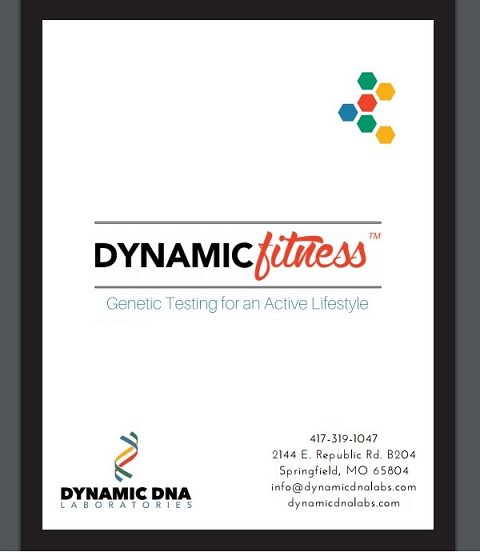
The front page of my report.
The report started with an introduction, and a ‘Basics of Biology’ section which explained some of the scientific facts and concepts related to the results. This was followed by a contents page, which revealed the basic results and where in the report to find out more detailed information about each. The results were sorted into the same categories that had been used in the product description on the website: ‘Build’, ‘Perform’, ‘Cardiovascular’, ‘Recovery’, ‘Metabolics’ and ‘Strength’
Results Section: BMI
Before my genetic results there was a section on my BMI, which had been calculated using information I’d provided (my height and weight). I was a bit shocked to see that, according to this measure, I’m classified as obese (which slightly put me off the slice of pizza I was tucking in to…)! This was a bit of a surprise and at first seemed like a bit of a negative start to the report. However, I soon realised that it was best to be aware of my starting point, in order to best use the results, understand my body and take action to improve my health.
Results Section: Build
The first category covered in the results themselves was ‘Build’. I wasn’t quite sure what this would include, so was pleased to see a short introduction to the section and another mini contents of the results included within it (shown below).
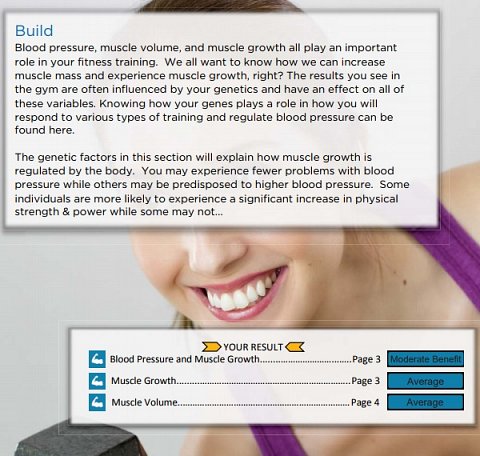
The introduction to the ‘Build’ section of my report.
The section included three results, ‘Blood Pressure and Muscle Growth’, ‘Muscle Growth’ and ‘Muscle Volume’. I was slightly worried when I first read the Blood Pressure and Muscle Growth result, which revealed I have a moderate susceptibility to high blood pressure. However, I was reassured when I read the (referenced) explanation which explained that although this had been linked to a slightly higher risk of high blood pressure, it also had benefits in terms of increased muscle growth and performance. I do have a tendency for high blood pressure, so it’s good to know that this isn’t completely a negative issue.
The other two results in this section analysed variants in the MSTN and IL15RA genes and indicated that I was likely to have average muscle mass, volume and strength.
Results Section: Cardiovascular
The next topics that were covered were cardiovascular issues related to fitness. This included six results that ranged from nitric oxide metabolism to vascular function. Of all of the sections this was probably the one that sounded most scientific when purely looking at the titles and I wasn’t quite sure what each would tell me.
However, looking at each result in detail, I found that they were thoroughly and straightforwardly explained. I learned that the variants I carried in the genes related to anaerobic exercise could possibly give me an advantage in endurance sports, which I’ve definitely found to be true.
Other results in this section suggested that my nitric oxide metabolism, and therefore blood flow during exercise, was likely to be average. Another again indicated my risk of high blood pressure, though this time suggested that it may impede my performance in endurance activities.
Results Section: Metabolics
The next section of the report was entitled ‘Metabolics’, which included five results. I wasn’t entirely sure what Metabolics was, but guessed that it would provide details to do with my metabolism. What I didn’t realise, until I read through the introduction, was that metabolism is involved in a lot more areas of health than I had thought. For example, my risk of high cholesterol levels and my insulin sensitivity were assessed.
The results in this section generally looked at how my body would likely respond to exercise, rather than my aptitude for different types, as the previous ones had focussed on. I was pleased to find that this section revealed quite a few genetic advantages. I learned that exercise was likely to increase my insulin sensitivity more than average. I wasn’t sure why this was beneficial, but the ‘Background’ that accompanied the result helpfully explained that increased sensitivity reduces the chances of developing type 2 diabetes.
I was particularly interested in the result that predicted I was likely to lose more fat from exercise than average (shown below).
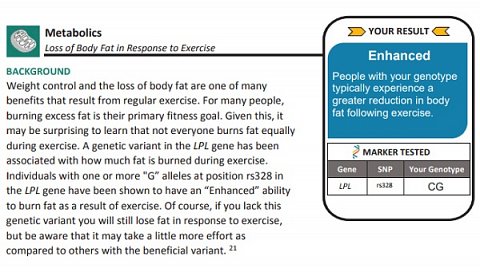
My Loss of Body Fat in Response to Exercise result.
I thought that the result was explained well and even without reading the explanation, the summary of the outcome and what it meant made it clear and easy to understand. I also appreciated that the information about the gene that had been analysed was included. I wasn’t sure at first what a ‘genotype’ and ‘SNP’ meant, but remembered the ‘Basics of Biology’ at the beginning of the report which, when I referred back to it, explained both terms clearly.
Results Section: Perform
The ‘Perform’ section of the report was mainly focussed on muscles which would be the best exercises to develop mine. Earlier suggestions that I was better at endurance sports (which I would agree with from experience) seemed to be contradicted by some of the results in this section, which recommended I focus on high-intensity exercises and a mixture of strength and endurance activities, rather than one or the other.
Something I particularly enjoyed about this section was the fact that an example of a ‘High Intensity Interval Training’ (HIIT) workout, was included. A section of it is shown below.

The first phase of the three-phase recommended HIIT workout.
Although I had to look up a few of the terms on Google (I had no idea what Wall Sits were!) I thought this was clearly laid out and seemed simple to follow. It provided a great starting point from which to give HIIT a go and I really enjoyed trying it out!
Results Section: Recovery
The report then moved on to information about how my body was likely to recover after exercise. I was interested to see that the results in this section ranged across several areas of recovery, including muscular, skeletal and even sleep factors.
For most of the results (osteoarthritis risk, Achilles tendinopathy, muscle recovery and sleep patterns) I was judged to be typical. However, the result that assessed my levels of lactate acid build up and removal explained that I was more at risk of fatigue during exercise. Although this sounded like a negative outcome, I was pleased to read that this was also associated with a lower chance of injury.
Results Section: Strength
I had assumed that the Recovery section would be the last one, so was surprised to find that there was a final ‘Strength’ part. I liked that there were several images accompanying the results in this section, and even an inspirational quote about strength, which helped to break up the information a bit.
Of the five results, which covered muscle strength, growth and development, as well as nerve activity and glucose metabolism, four determined me to be average. The fifth one was probably my favourite in the report though. It revealed that even without exercise, I’m likely to have naturally quite strong muscles!
Results Section: Methodology, Limitations and References
The report ended with a short section outlining the methods that had been used to analyse my DNA and provide the results, followed by some of the limitations of the test. I was impressed that this was included, and it increased my trust in the results. This was further consolidated by the reference list, which included an impressive 44 scientific studies that had also been referenced at the relevant points throughout the results.
Summary
The Dynamic Fitness DNA test provided a detailed yet straightforward insight into my body and provided excellent suggestions about how to improve my fitness routine. I was able to clearly link many of the results to my own experiences and felt that the advice would be easy to implement. I particularly appreciated the inclusion of an example HIIT workout to follow.
It found it a little disconcerting when the report started by classing me as obese, according to my BMI. However, I quickly saw that this was a useful benchmark from which to roughly assess and start improving my fitness. Overall, the test offered lots of information that was well referenced and would be a great tool for anyone looking to improve their fitness routine.
Please note that we were invited to take this test free of charge.
See a description of this DNA test from Dynamic DNA Laboratories >
At a Glance
Summary
The Dynamic Nutrition report provided interesting and practical insights into my diet, which have given me a range of new, sustainable ways to lose weight and maintain a healthy lifestyle. The fact that each of the report was so well referenced, linking to over 70 studies in total, made the results and associated recommendations all the more valuable and gave me the opportunity to explore far beyond the report.
It was a shame that one of the results was repeated and that a couple seemed to contradict each other, but overall, this colourful report was packed full of results that I look forward to using to improve my lifestyle.
Full Review
Dynamic DNA Laboratories is a company that offers customers several different types of DNA test, ranging from ancestry to art.
As well as the consumer side of the business, their laboratory has produced results that have been published in numerous academic journals and their staff have worked in areas including scientific research, clinical testing and even forensics. Unlike some other labs that outsource the processing of samples, all of the cheek swabs used for Dynamic DNA’s tests are processed in their own on-site laboratory. Their hope is that people will use their DNA tests to gain a better understanding of themselves to help them lead healthy and happy lives.
Product Expectations
I learned from the Dynamic DNA website that the Dynamic Nutrition test would assess 28 different traits, which would be used to help me to ‘improve diet, harness energy and lose weight’. It would do this by determining my optimal diet type and my likely reactions to gluten, lactose, alcohol and caffeine. It would also identify predispositions to conditions related to diet, such as metabolic rate, cholesterol and blood sugar levels and determine whether I need to increase my levels of certain vitamins or folates.
There was a list of the traits that would be assessed in the test, which were split into the following categories: ‘Diet’, ‘Nutritional’, ‘Reactions’, ‘Behaviors’ and ‘Metabolic’. Strangely, this didn’t seem to include 28 traits overall, but it was still beneficial to have an idea of what would be included in the test.
I went through the terms and privacy policy and didn’t find anything that concerned me. I was pleased to see that those under 18 years of age were not permitted to use Dynamic DNA’s test kits.
Ordering Experience
The test was easy to order from the Dynamic DNA website. I was given the option to pay by credit card on the site, or via PayPal and was pleased to see that shipping was included in the price. Once my payment had gone through I received a confirmation email and my kit was delivered a few days later.
I took my samples and sent them back to the lab with a signed informed consent form that had come with the kit. This was mainly used to outline the limitations that I should be aware of when taking the test, though it also informed me that my sample would be retained in the Dynamic DNA laboratory, for ‘in-house validation’. I wasn’t sure what this meant in practical terms.
An email confirmed that my samples had reached the lab, and another notified me that my results were available.
The Results
My results were accessible via the Dynamic DNA portal, as a downloadable PDF file. The front cover looked professional and had been personalised with my name. This was followed by an introduction, which explained the basics of genetic variation and how it linked to diet and fitness in the report. It was signed by Austin O’Reilly, the founder of Dynamic DNA Laboratories, which I thought was a nice touch. The report continued to a ‘Basics of Biology’ page which explained some of the scientific concepts and terms used in the report, which is shown below.
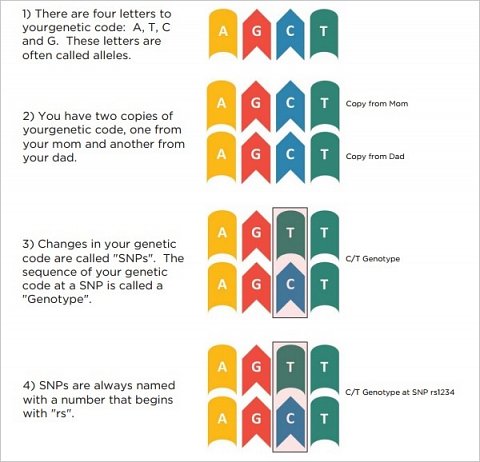
The Basics of Biology explanation.
The colourful diagrams that accompanied the information made the already well-explained concepts even clearer.
Once I’d read through this introductory information, I scrolled down to the contents page (shown below).
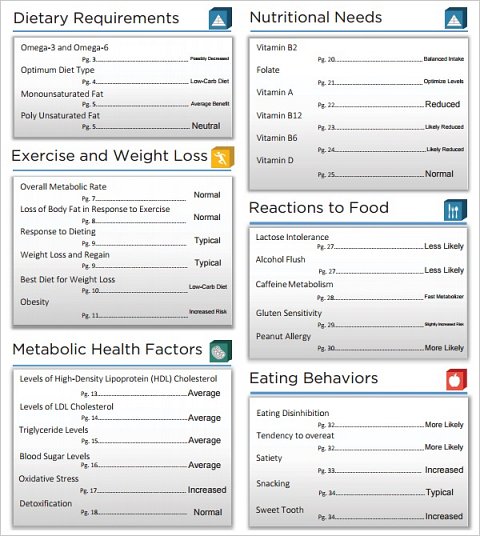
The contents page.
This not only provided a list of where in the report to find information about the different traits, but served as a summary of my results. I liked that each section included its own distinct symbol, but wasn’t quite sure why the size of the text differed between the results included. I guessed that it could be to illustrate the varying significance or level of detail of each of them.
Results Section: Dietary Requirements
Each section of the report had its own title page that included a bright image in the background of a short introductory paragraph and summary of the results in that section. The summary from the Dietary Requirements title page is shown below.
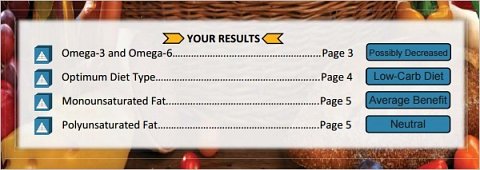
My Dietary Requirements results summary.
It was helpful to have this introduction to the section which clarified exactly what were considered as important dietary requirements.
The results told me that, according to my DNA, I was susceptible to lower than average levels of Omega-3 and Omega-6 in my blood plasma, but was likely to have a normal reaction to mono- and poly-unsaturated fats (though should still incorporate these healthy types of fat into my diet).
The most comprehensive result was the ‘Optimum Diet Type’ which informed me that my body would likely react best to a diet low in carbohydrates (shown below).
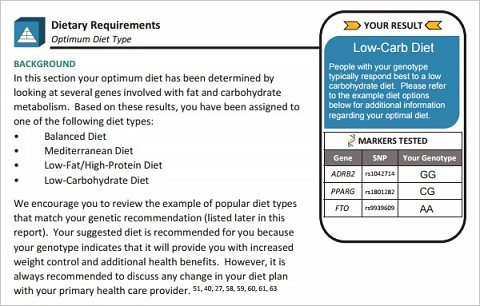
My Optimum Diet Type result.
As well as the result itself, I was provided with background information, including the different results that I might have received rather than mine, and subsequently the different diets that could have been recommended. The next page went into even more detail, giving information about different types of carbohydrates and tips on how to follow a low carb diet. This even included a three-day meal plan, which seemed really straightforward and easy to adapt to.
Results section: Exercise and Weight Loss
The next section in the report was based around exercise, and specifically how my body was likely to respond in terms of weight loss. It was made up of more results than the previous section – six in total – and included advice about losing weight, but also keeping it off in the long term.
I was interested to learn that although my body was likely to respond to dieting in a typical way, I had a genotype which meant I was more prone to regaining the weight after I’d lost it. It was nice to know that regaining weight after dieting isn’t necessarily down to laziness or lack of will power. Unfortunately, there wasn’t any specific advice about how to overcome this genetic disadvantage, other than to maintain a healthy diet and active lifestyle.
The next result was about my optimum diet type and included mostly the same information as the optimum diet result from the previous section. I thought that perhaps this result was based on the analysis of different genes, but when I compared them I found that they were the same. However, when I read the background to each it was clear that the result in this section was explained with more of a focus on why the diet was optimal for weight loss than in the previous section, which had talked about the more general benefits.
Other results in this section were related to how my body would respond to exercise. I found out that I was likely to have a normal resting metabolic rate, and that my body was likely to respond typically to physical activity.
I was most interested in the final result in this section, which assessed my genetic predisposition to obesity. I was really impressed by how well the so-called ‘fat gene’ was explained and referenced.
My result determined that I was more likely to be obese, which in practical terms affects not just the amount I’m likely to eat, but how easily I become hungry and full before and after eating. It also suggested I would respond more poorly to exercise and have a slower metabolism, which was slightly confusing, as the previous results had suggested that I would respond normally and had an average metabolic rate.
Results Section: Metabolic Health Factors
The Exercise and Weight Loss results were followed by the Metabolic Health Factors section. This also covered six traits, but ones which were less physically observable than in the previous results.
The first two of these results were based on the likely levels of different types of cholesterol I would have in my blood. Although I was familiar with the idea of having high or low levels of cholesterol, I hadn’t realised that there were good (HDL) and bad types (LDL).
As well as explaining this, the two results, that determined I was likely to have average levels of both types, included information about why one was considered good and the other bad. I loved that they’d included a cartoon with an LDL devil and HDL angel. In addition to adding some colour and light-heartedness to the result, it provided a memorable visual reminder of the difference between the two.
Other results in this section revealed that I was likely to have average triglyceride (a type of fat) and fasting glucose levels. Diabetes runs in my family, so it was reassuring to know that I wasn’t’ genetically predisposed to high levels of glucose, which is one indicator of a higher likelihood of developing the disease (though it was made clear that this wasn’t a result assessing my genetic predisposition to diabetes).
This section also included results that revealed I was genetically predisposed to increased oxidative stress, but a normal level of detoxification. I wasn’t sure what either of these processes were before reading through the results, but learnt that oxidative stress happened when harmful chemicals, produced from the processing of food, can damage cells and that detoxification was a process where harmful environmental substances are removed from the body.
Dynamic DNA had included food suggestions to increase my antioxidant intake, which help to protect against oxidative stress. I was particularly pleased to see that dark chocolate was one of the recommendations!
Results Section: Nutritional Needs
Next, I moved on to the section that provided results about which vitamins and mineral I was likely to need more/less of. The results covered vitamins A, B2, B6, B12, D and folates. I learnt that I likely needed to increase my intake of all but vitamin A and D. Rather than just telling me this, however, I was glad to see that the mechanisms that were likely to result in a deficiency were explained.
This information was easy to follow and straightforward. I felt it increased my understanding, as well as my interest in the results, especially as there were also helpful suggestions of which foods had high levels of each of the vitamins, rather than just supplement recommendations.
Results Section: Reactions to Food
The penultimate section of the report covered possible reactions to food, such as lactose intolerance and peanut allergy, and was probably the easiest section to compare directly to my own experiences.
The results correctly predicted that I wasn’t intolerant to lactose or alcohol, though assessed that I was more likely to have a peanut allergy and be gluten intolerant. I don’t currently suffer from either of these conditions, but it was explained that this result didn’t mean I definitely would, just that I was more likely to than average. I also learned that peanut allergies were one of the most common allergies that develop in adulthood, so this was definitely something worth being aware of.
This section also included a result that indicated I was a fast metaboliser of caffeine, which corroborated what I had learnt from other tests. This result was accompanied by a useful diagram that showed the different levels of caffeine in different drinks (shown below).
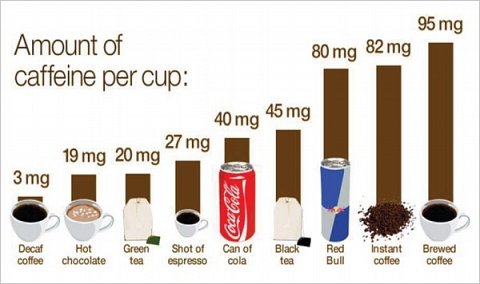
The diagram that accompanied my Caffeine Metabolism result.
This was one of many similar diagrams and images that accompanied the results in the report, which helped to make some of the concepts easier to understand and reduced the amount of block text there was to read. I was surprised to see that even decaf coffee contained some caffeine, and that Red Bull included nearly as much as instant coffee!
Results Section: Eating Behaviors
The final section assessed my general eating behaviours. It covered five traits in total, all of which were easy to compare to my actual eating behaviours. The main conclusions made in this section was that I am genetically inclined to overeat, eat in response to emotion, and have a sweet tooth. Interestingly, my results indicated that I wasn’t likely to excessively snack, which although I’ve never really thought about, is true.
Summary
The Dynamic Nutrition report provided interesting and practical insights into my diet, which have given me a range of new, sustainable ways to lose weight and maintain a healthy lifestyle. The fact that each of the report was so well referenced, linking to over 70 studies in total, made the results and associated recommendations all the more valuable and gave me the opportunity to explore far beyond the report.
It was a shame that one of the results was repeated and that a couple seemed to contradict each other, but overall, this colourful report was packed full of results that I look forward to using to improve my lifestyle.
Please note that we were invited to take this test free of charge.
See a description of this DNA test from Dynamic DNA Laboratories >
At a Glance
Summary
Dynamic DNA Laboratories provided interesting and helpful guidance, presented in a clear, easy to understand format. Inconsistencies in the phrasing let the report down in areas, and I would have liked more exercise-focused information. That said, the information provided was useful and detailed. The long list of references was also impressive.
I particularly liked the sample meal plans and the (sometimes surprising) nutritional information that accompanied them. The background information and explanations provided for each result were also excellent.
I would recommend this test to anyone interested in developing a personalised diet and fitness plan based on their DNA. The plans recommended by Dynamic DNA Laboratories are clearly backed by scientific evidence, and are easy to implement.
Full Review
Dynamic DNA Laboratories is a company that not only carries out its testing in its own laboratory, but has published research in a number of academic journals. It offers a range of tests, from genetic art to ancestry, and is headed up by Austin O’Reilly, a biology graduate from Springfield, MO. Their fitness test offers information about 31 genetic traits associated with nutrition and fitness.
Product Expectations
The test itself is called ‘Dynamic Fitness and Nutrition’ and is designed to help customers improve their energy levels, athletic performance, diet, and hit their weight-loss goals. I had a good idea of what to expect from browsing the Dynamic DNA Laboratories website, which not only provided screenshots of sample results but described all the traits that would be reported on. These were categorised into six main sections, making it quick and easy to assess the main areas of focus. The website also emphasised that the product is for everyone: “Whether you are 40 pounds overweight or have run two marathons in the last month”.
Looking at the terms and conditions was interesting. Whilst there was nothing particularly surprising in the terms themselves, the section which I was most interested in, entitled “Personal Information, Privacy Policy” stated that the privacy of personal information was governed by their privacy policy. However, there wasn’t a hyperlink to this policy and I couldn’t find it anywhere else on the site!
Ordering Experience
The site was really simple to use and the ordering process was straightforward. I received a confirmation email after ordering.
The test kit arrived a few days later, it contained instructions, a consent form and return packaging. I was a little disconcerted by the consent form as it included several mentions of my predisposition to disease. However, as nothing about this was included in my report I assume that, as Dynamic DNA Laboratories also offer predisposition tests for disease, they use the same consent form for all their tests. It may also have been an acknowledgement that I could, in theory, use my results to get health information from third party providers.
The Results
A few days later I received an email to tell me that my results had reached the lab, and a week after that I was informed that my samples had been uploaded to an online portal. It was easy to log in and my PDF report started downloading automatically. The results were organised into six sections: ‘Eating Behaviors’, ‘Metabolic Health Factors’, ‘Exercise and Weight Loss’, ‘Nutritional Needs’, ‘Dietary Requirements’ and ‘Reactions to Food’.
Before going through the sections, I read Dynamic DNA Laboratories’ introduction to genetic testing which was helpful. A handy contents page outlined the different sections and which traits were included in each, but it’s a shame that links to the corresponding results hadn’t been incorporated. There was also a page on Body Mass Index (BMI) which was an interesting addition and put the results into context.
Results Section: Eating Behaviors
The first section I looked at was Eating Behaviors, where a brief introduction and summary were provided, shown below:

My Eating Behaviors summary.
An explanation accompanied each result to describe the trait in greater detail, highlight the gene that was analysed, and go through the genetic variants that were associated to greater or lesser expressions of that trait. My satiety result and explanation are shown below:
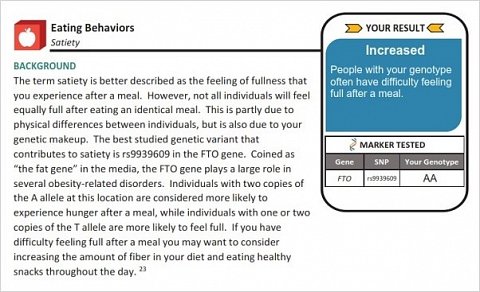
My satiety result and explanation.
As you can see, my result was helpfully expanded upon in a box to the right of the explanation. I learned that “People with my genotype often have difficulty feeling full after a meal”, which I would definitely agree with as I’m almost always hungry! I wasn’t entirely sure what ‘genotype’ meant, and there were other words such as ‘allele’ that I also found confusing, so some sort of glossary might have made the results a bit clearer.
I was impressed by the fact that each result had at least one footnote (some had as many as nine), that linked to a comprehensive reference list at the end. All references were from academic journals and a few Google searches confirmed that the research was from mainstream, respected publications, most notably Nature Genetics, which is one of the most influential journals in its field.
Although I was pleased that Dynamic DNA Laboratories had linked each result to a gene (so that I could conduct further research if I wished), it was a shame that the term ‘SNP’ was used but not explained. An internet search revealed that it was simply another term for genetic variant, but it would have been easier if Dynamic DNA Laboratories had stuck to the term ‘genetic variant’ throughout the whole report. Fortunately, any uncertainty I had about terms didn’t prevent me from deriving meaning from my results, so I wouldn’t say this was a major issue.
The rest of the results relating to my eating behaviours were pretty accurate. I’m not overweight (the results predicted that I’m not prone to overeating) but I do tend to indulge in times of stress or on special occasions (the results predicted that I had a higher than average likelihood of displaying eating disinhibition).
Results Section: Exercise and Weight Loss
The next section I looked at was the Exercise and Weight Loss section. As I mentioned, I’m not overweight and I enjoy exercise, so I was hoping Dynamic DNA Laboratories were going to suggest improvements to my workout which would enhance my physical fitness. Unfortunately, this section focused more on the weight-loss aspects of exercise, and my only takeaway was that I’d be more likely to respond to endurance-based training. I’m already more inclined to practice this type of activity so this wasn’t a major revelation.
The diet recommendations indicated that my body would respond well to a low-carb diet if I was trying to lose weight. I was sceptical at first as I’ve heard negative things about low-carb diets in the past, however, I was pleased to see that the meal plan made sensible recommendations such as switching refined carbs (such as pasta and white bread) for complex ones (such as lentils, beans and brown rice). The suggestions for breakfast, lunch and dinner sounded substantial and filling, and I could see that this plan would be an effective tool for losing weight and improving my nutritional health. The meal plan is shown below.
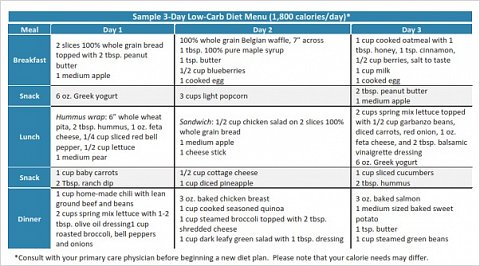
My low-carb meal plan.
Results Section: Metabolic Health Factors
The next section I looked at concerned my metabolic health and the factors affecting it. It focused on cholesterol, fat and blood sugar levels. I was glad the report acknowledged that DNA isn’t the only factor affecting these levels. It might otherwise have been tempting to ditch the healthy meal plan for a pizza-based diet, after discovering I was predisposed to higher levels of HDL (good) cholesterol!
Results Section: Nutritional Needs
The Nutritional Needs section focused on vitamins and minerals and whether or not I was likely to be deficient in them. Most of the results indicated that I was not likely to suffer from any deficiencies. I was surprised that folate deficiency wasn’t flagged, as this is something I suffer from and previous DNA tests have recognised. It may have been that Dynamic DNA Laboratories analyse different genetic variants for folate deficiency compared to the other providers I’ve taken tests with.
Results Section: Dietary Requirements
This section was similar to the Exercise and Weight Loss section, but focused on dietary advice associated to fats and proteins. Dietary plans were provided along with nutritional tables. One table showed the amount of fat in various foods such as meats and nuts (shown below), with others covering carbohydrates and proteins. I was shocked to learn that an avocado contains more fat than a donut! Fortunately, Dynamic DNA Laboratories distinguished between the different types of fat and explained that unsaturated fat (found in avocados) is much healthier than trans-fat (found in donuts).

Advice on different types of fat.
Results Section: Reactions to Food
The final section was about three physiological reactions: Lactose intolerance, caffeine response and alcohol flush. These results showed that, as expected, I was not likely to have adverse reactions to alcohol or lactose. It also identified that I’m likely to metabolise caffeine slowly and should therefore restrict myself to one or two cups a day. Funnily enough, I already limit myself to two cups a day even though I don’t remember making a conscious decision to do so. I must have been unconsciously responding to my natural caffeine metabolism!
Summary
Dynamic DNA Laboratories provided interesting and helpful guidance, presented in a clear, easy to understand format. Inconsistencies in the phrasing let the report down in areas, and I would have liked more exercise-focused information. That said, the information provided was useful and detailed. The long list of references was also impressive.
I particularly liked the sample meal plans and the (sometimes surprising) nutritional information that accompanied them. The background information and explanations provided for each result were also excellent.
I would recommend this test to anyone interested in developing a personalised diet and fitness plan based on their DNA. The plans recommended by Dynamic DNA Laboratories are clearly backed by scientific evidence, and are easy to implement.
Please note that we were invited to take this test free of charge.
See a description of this DNA test from Dynamic DNA Laboratories >


